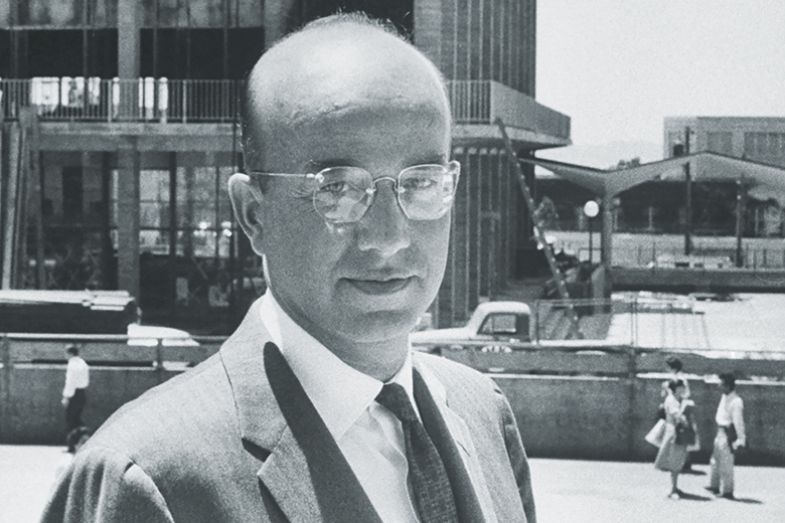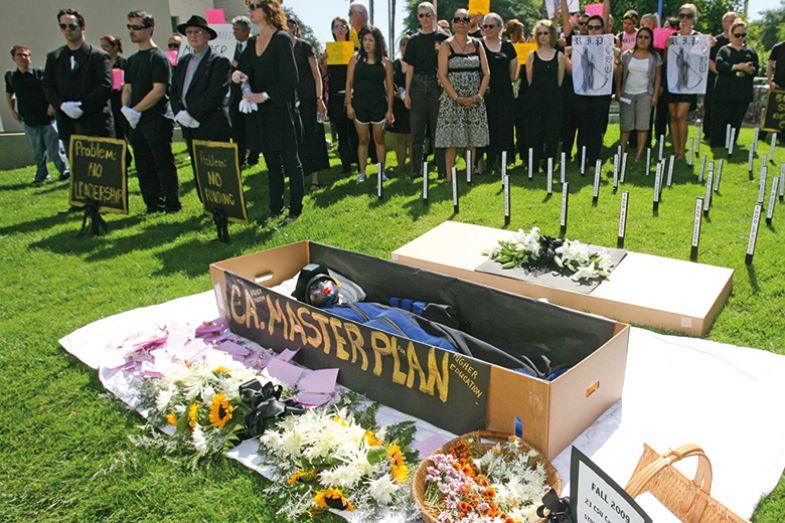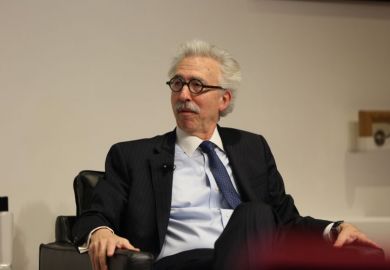Clark Kerr, the first chancellor of the University of California, Berkeley, is best remembered as the architect of California’s Master Plan for Higher Education – which he drew up in his subsequent role as president of the University of California System in 1960. The plan is still the gold standard for those seeking a balance between universal access to higher education and the highest levels of excellence in both research and education.
Soon after his triumph, however, Kerr (pictured below) got caught between the rise of the 1960s student movement around free speech and the emerging political reaction against universities. This reaction was symbolised most conspicuously by Ronald Reagan’s promise, during his run for the California governorship, to “clean up the mess at Berkeley”. Fired by the regents in early 1967, soon after Reagan’s election, Kerr could at least take satisfaction that the Master Plan endured to his death in 2003.
Despite his educational vision and accomplishment, Kerr spent a considerable amount of his time after stepping down defending his administrative record. He was, for example, offended that some student activists, including the celebrated Mario Savio, accused him of being an apologist for the “multiversity” that activists felt rendered individual students mere cogs in a corporate machine.
Kerr had coined the term “multiversity” to capture the extent to which the university had ceased to be a single community. As he wrote: “The university is so many things to so many different people that it must, of necessity, be partially at war with itself.” He was deeply concerned that individual students, especially undergraduates, were ill-served by this development, and he was relentless in his critique of faculty who had become autonomous entrepreneurs and members of guilds connected far more vitally to their professional cohort than to the university more broadly.
He wrote that in all intellectual and social revolutions, “the university, as an institution, was initially more a ‘stronghold of reaction’ than a revolutionary force”. Collectively, the faculty are rarely the agents of change, he noted, except when there are new institutes, departments or campuses that provide innovative spaces outside the institutional inertia of the academy.
But he firmly believed that “the great universities of the future will be those which have adjusted rapidly and effectively…to the important new possibilities”. And he saw the multiversity not just as a necessity but as a new institutional form that was creative, adaptive and productive in unprecedented ways – provided enlightened administrators were in place to accommodate and balance its array of often-competing visions and interests, including those of society at large.
For Kerr, the imperative to change was no different from the imperative to stay both relevant and excellent. The challenge for university administrators was “to make the collective faculty a more vital, dynamic, progressive force”. That went alongside “making the old departments and divisions more compatible with the new divisions of knowledge” and making it possible “for an institution to see itself in totality rather than just piecemeal, and in the sweep of history rather than just at a moment of time”.

Clark Kerr
He hoped that universities could avoid becoming like the proverbial dinosaur that became extinct because – as George Beadle, then president of the University of Chicago, put it – “he grew larger and larger and then sacrificed the evolutionary flexibility he needed to meet changing conditions”.
Today, Kerr would doubtless still be concerned about how he was misunderstood: such is the afterlife of administrators. He would, however, be far more concerned about the steady demise of the Master Plan, and he would be thinking about new ways to adapt it to changing circumstances.
The fundamental problem, which has escalated in almost exponential ways in the 15 years since Kerr’s death, has been the precipitous decline in state funding. Despite the strong rebound of California’s economy since 2008, public spending on the education of each in-state student is still less than half its pre-recession level.
This decline has begun to compromise the capacity of the University of California to compete with top private universities, and has stemmed any serious effort to expand its promise of access to all qualified applicants. While the Kerr-era campuses in Davis, San Diego, Santa Cruz and Irvine all grew quickly in size and reputation, the only campus to be built since, Merced, has struggled to establish itself as a full sister campus of the storied system since opening in 2005.
As chancellor of Berkeley 60 years after Kerr, and confronted with a yawning budget deficit and an unyielding state government, I suggested a fundamental reimagining of the university. It was not a popular idea then, and, for reasons made clear by Kerr, it is not likely to be viewed with favour any time soon. Perhaps I should have kept such thoughts to myself and avoided prompting faculty to band together to pass a resolution insisting that no change of academic programme could take place without the full endorsement of the relevant faculty group (meaning that nothing major would change). In the months since stepping down, however, I have had time to think more broadly about the problems faced by American universities, and potential ways forward. And it is clear to me that a radical rethink is indeed what is required – and that someone has to say so.
Most indications are that both state and federal funding will continue to decline. In-state students resist any further increases to already higher tuition fees, and the recent political movement for “free college” has captured wide public support for obvious reasons. Most top public universities make ends meet by recruiting ever greater numbers of out-of-state students, who pay even higher fees but whose massed presence subverts the original justification for having flagship public institutions in each state.
And universities do many other things for reasons of financial necessity that earn widespread criticism, from hiring ever more non‑tenure-track faculty to devoting increasing resources to fundraising and leveraging assets for new revenues. Despite the success of some of these measures, the level of competition for scarce resources within universities has steadily increased – and the level of support for change has decreased in equal measure.

While faculty correctly mount spirited defences of their autonomy to determine curricula and their freedom to research and opine on what they want, they also need to work much more closely with administrators to confront the need for real structural change given the realities of our situation. The current stalemate between faculty senates and university administrations is too often dysfunctional, leading to administrative efforts to sideline the role of faculty groups on the one side, and growing faculty distrust of administrators’ good faith on the other.
Profound change is necessary not only to restrain costs, but also to reinvigorate the university at a time of growing public disenchantment and massive social, political and technological change. But what form might this change take? Should we accept, for example, the conclusion of Kevin Carey, vice-president for education policy and knowledge management at the New America thinktank, that – with some rare exceptions – we should embrace the “end of college” – because we now have the technological means to provide high-quality, low-cost education for “all”?
I don’t believe so. But traditional universities certainly need to educate many more students – from a wider range of backgrounds and with a broader range of interests. This is our primary obligation, and the core of our fundamental claim to serve the public good. But we need to do this without any diminution of educational quality. Yes, we will need to use technology more aggressively, but we must not give up on college as a residential experience.
Universities are already flipping classrooms – investing more in small-group discussion than in the maintenance of the large lecture format – while supplementing the teaching and mentoring experience with ever more sophisticated online platforms. But we could do much more. We could, for example, be more flexible regarding our entry requirements, accepting credits for valid online courses. And we could allow our students to move in and out of four-year college education much more flexibly, allowing them to take advantage of opportunities to study elsewhere (including overseas) or to take up internships or pursue projects that don’t fit within the precise structures of departmental majors.
As we come to terms with the extent to which the contemporary multiversity must train students for entirely different kinds of careers from those college graduates have traditionally pursued, we must also accept that an increasing number of students are “non-traditional”: older students who need to retrain in new fields. In fact, we need to create non-traditional pathways for all students, adjusting our programmatic calendars and degree requirements to allow them to avail themselves of growing experiential opportunities and online resources, offering new kinds of training and credentialing.
It may be necessary to devise new kinds of degrees and certificates for new areas of learning; and it should be possible to design courses that can provide a genuine liberal arts education taught by faculty from vastly different fields and departments. Undergraduates do not need to be trained as if they are going to go on to PhDs, and the structure of both majors and electives should reflect more common educational goals that can be mounted efficiently as well as effectively.
We also need to open ourselves to new ideas about how faculty are hired, curricula are mounted and programmes are organised. It should be as easy to sunset older programmes and institutes as it is to create new ones; it should be routine to merge smaller units to create more workable institutional structures.

This should not be seen as a way to curtail faculty prerogatives, especially in fields such as the humanities that have routinely been targeted by administrative restructuring efforts but which our students need more than ever. However, faculty may have to give up some of their independence in areas such as choosing what they teach each semester. In return, they will receive additional flexibility around their teaching and mentoring schedules, as well as the research and professional development pathways they want to pursue.
Howls of protest against major changes are inevitable from faculty and students alike. However, curricula and departments in most universities have remained more or less the same for more than 50 years – as have the internal quarrels between departments. Across-the-board cuts exacerbate these tensions and provide only a temporary solution to the deeper systemic problem: the failure of academic structures to reflect and incubate broad cross-disciplinary teaching and research that is fully engaged with the world outside the university. Faculty will have to work with administrators to make this possible, while continuing to advocate for the priorities of a genuine academic mission.
Curricula should be redesigned to align with the changed nature of knowledge, scholarship, research and intellectual work. Building a more flexible academic architecture would enable better support for cross-disciplinary and cross-institutional collaboration, while acknowledging the need to find new ways to hire faculty and to credential students as they engage in more flexible forms of learning across their lifetimes. And it would tap into the dynamism and innovation that Kerr observed to take place on the edge of traditional university structures.
A new Master Plan for California – or anywhere else – must therefore be less top-down, articulating a network rather than a closed system, merging and connecting educational resources for common goals. Just as students should be enabled to move fluidly between universities and other venues, so faculty could be hired with appointments not just in multiple departments but in multiple universities.
In short, the modern American university will be more a curator than a sole provider of education. This will doubtless exacerbate in some ways the internal contradictions and tensions that Kerr identified in the multiversity. As with his original vision, however, this opens up the university to new opportunities, while necessitating that more attention be paid to the actual student experience. Although the further expansion of the multiversity requires us to think more about how effectively to build broader community feeling (and not just through sports), we can at the same time use technology to allow greater personalisation and customisation of education.
Public universities, including flagship campuses such as Berkeley, require greater independence than they currently have, from both government and the overarching university system. But they also need new forms of governance in order to innovate more quickly and to open themselves to new institutional possibilities. Some of these possibilities may include institutional mergers as well as loosely affiliated networks across state and national borders, including closer collaboration between public and private sectors.
At the same time, we all need to focus more resources on the lower tiers of the system: the community colleges and the more challenged state schools that have fewer opportunities for leveraging private funding and more capacity to draw in students from multiple backgrounds. We should provide incentives for public and private institutions to innovate by creating new pathways to associate degrees, creating a vital network of new and reinvigorated two-year colleges that can provide the cultural and intellectual capital needed to ready larger numbers of students for higher-level college study. Something like this is already being attempted by Bard College, whose “micro-college” pilots aim to bring high-quality liberal arts education to excluded communities in America’s north-east, in partnership with community-based institutions.
Kerr spoke and wrote about the university as the “city of intellect”. Since his time, that city has grown into a global metropolis of unprecedented scale and complexity. It is now a dizzying assemblage of structures that it can no longer pretend to fully control: networks of individuals and communities, relationships and partnerships that extend far beyond the department, campus or even nation. Still, if we take what I suggest here as the basis for a sustained and collective reimagination, this new multiversity can still be the dominant intellectual engine of the 21st century.
Nicholas Dirks was the 10th chancellor of the University of California, Berkeley.
POSTSCRIPT:
Print headline: The city of intellect, reimagined
Register to continue
Why register?
- Registration is free and only takes a moment
- Once registered, you can read 3 articles a month
- Sign up for our newsletter
Subscribe
Or subscribe for unlimited access to:
- Unlimited access to news, views, insights & reviews
- Digital editions
- Digital access to THE’s university and college rankings analysis
Already registered or a current subscriber?






